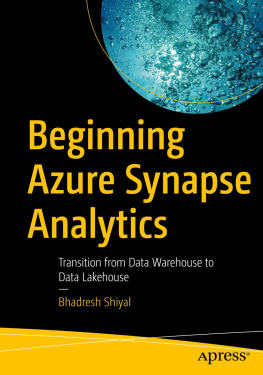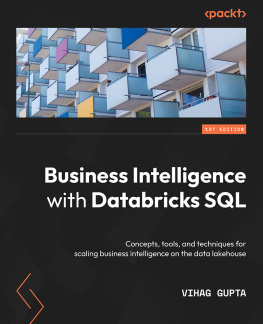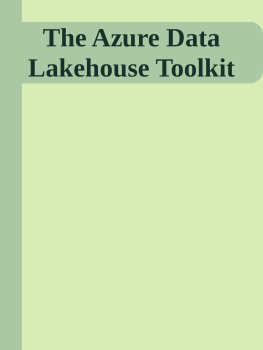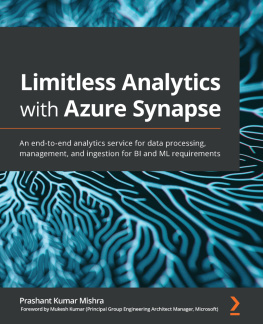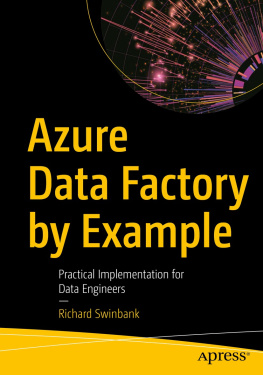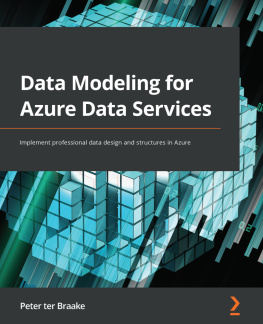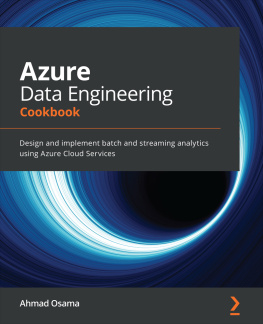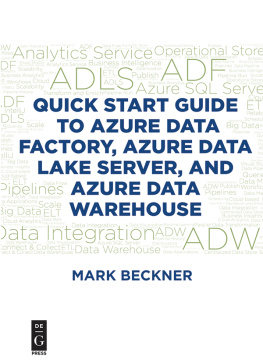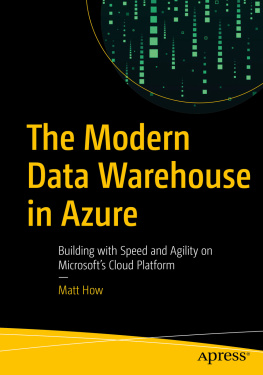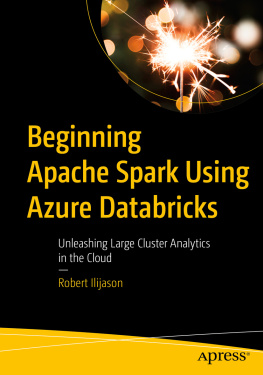Bhadresh Shiyal - Beginning Azure Synapse Analytics: Transition from Data Warehouse to Data Lakehouse
Here you can read online Bhadresh Shiyal - Beginning Azure Synapse Analytics: Transition from Data Warehouse to Data Lakehouse full text of the book (entire story) in english for free. Download pdf and epub, get meaning, cover and reviews about this ebook. year: 2021, publisher: Apress, genre: Politics. Description of the work, (preface) as well as reviews are available. Best literature library LitArk.com created for fans of good reading and offers a wide selection of genres:
Romance novel
Science fiction
Adventure
Detective
Science
History
Home and family
Prose
Art
Politics
Computer
Non-fiction
Religion
Business
Children
Humor
Choose a favorite category and find really read worthwhile books. Enjoy immersion in the world of imagination, feel the emotions of the characters or learn something new for yourself, make an fascinating discovery.
- Book:Beginning Azure Synapse Analytics: Transition from Data Warehouse to Data Lakehouse
- Author:
- Publisher:Apress
- Genre:
- Year:2021
- Rating:5 / 5
- Favourites:Add to favourites
- Your mark:
- 100
- 1
- 2
- 3
- 4
- 5
Beginning Azure Synapse Analytics: Transition from Data Warehouse to Data Lakehouse: summary, description and annotation
We offer to read an annotation, description, summary or preface (depends on what the author of the book "Beginning Azure Synapse Analytics: Transition from Data Warehouse to Data Lakehouse" wrote himself). If you haven't found the necessary information about the book — write in the comments, we will try to find it.
Bhadresh Shiyal: author's other books
Who wrote Beginning Azure Synapse Analytics: Transition from Data Warehouse to Data Lakehouse? Find out the surname, the name of the author of the book and a list of all author's works by series.
Beginning Azure Synapse Analytics: Transition from Data Warehouse to Data Lakehouse — read online for free the complete book (whole text) full work
Below is the text of the book, divided by pages. System saving the place of the last page read, allows you to conveniently read the book "Beginning Azure Synapse Analytics: Transition from Data Warehouse to Data Lakehouse" online for free, without having to search again every time where you left off. Put a bookmark, and you can go to the page where you finished reading at any time.
Font size:
Interval:
Bookmark:
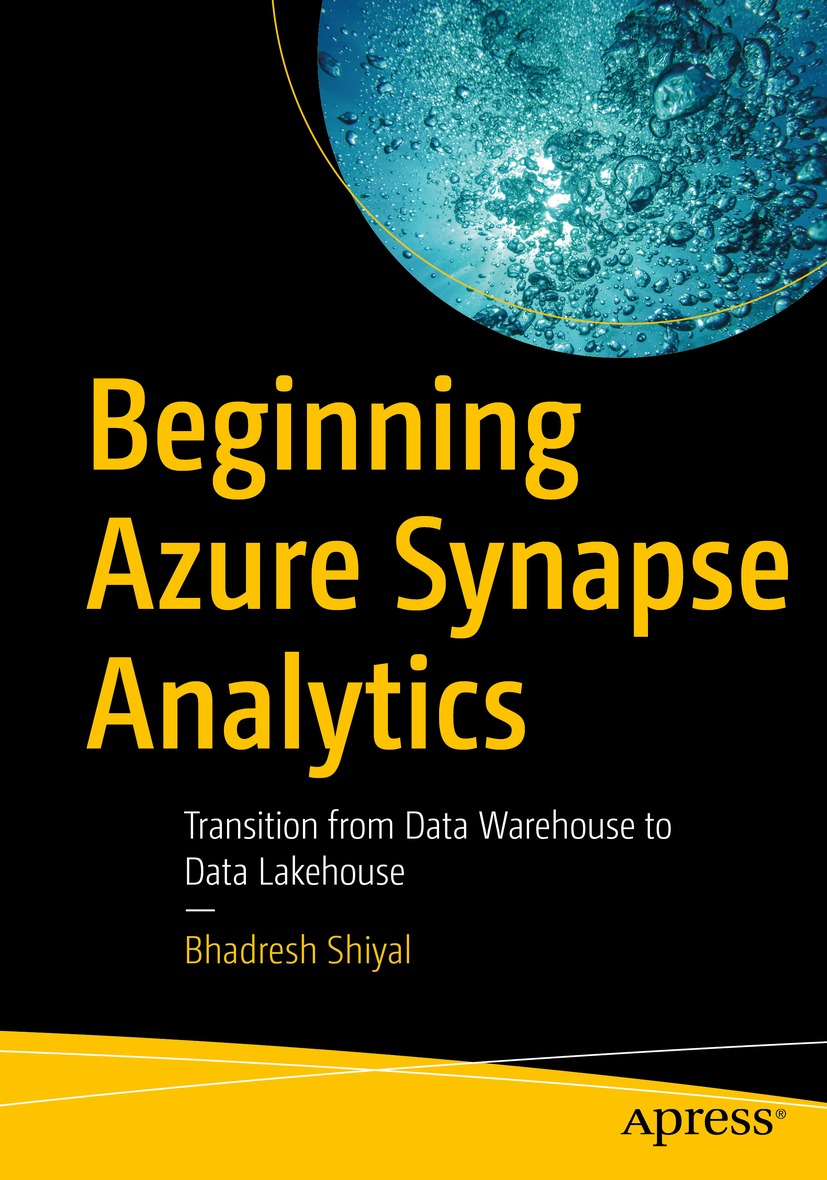

Any source code or other supplementary material referenced by the author in this book is available to readers on GitHub via the books product page, located at www.apress.com/978-1-4842-7060-8. For more detailed information, please visit http://www.apress.com/source-code.
This Apress imprint is published by the registered company APress Media, LLC part of Springer Nature.
The registered company address is: 1 New York Plaza, New York, NY 10004, U.S.A.
Dedicated to my wife, Priti, and my daughter, Jiya.
This book is about beginning to learn Azure Synapse Analytics. It is the most modern data analytics platform offered by Microsoft. It is always challenging to start learning a new IT skill, as you will have to learn new jargon, concepts, methods, tools, and technologies as part of the process. Azure Synapse Anlaytics is no different. I hope that this book will give you a solid technical foundation for starting your journey in the new world of Azure Synapse Analytics.
Anyone with a little IT background, particularly in Azure cloud, will be able to understand the content of the book very easily. The book is targeted to data analysts, data engineers, data scientists, data architects, solution architects, Azure developers, Azure administrators, and so forth who are keen to begin their Azure Synapse Analytics journey. This book will be a good starting point. I have concentrated on some basic concepts in the first two chapters so that it becomes easy for anyone to start learning about Azure Synapse Analytics.
Chapter : Core Data and Analytics Concepts introduces readers to some of the important core data and analytics concepts as a foundation.
Chapter : Modern Data Warehouse and Data Lakehouse provides conceptual understanding about traditional/legacy data warehouse, modern data warehouse, and finally the most modern data lakehouse.
Chapter : Introduction to Azure Synapse Analytics builds foundational knowledge by introducing Azure Synapse Analytics, its main features, and its key services capabilities.
Chapter : Architecture and Its Main Components explains Azure Synapse Analytics core architecture and its main components, as it is very different from traditional data warehouse architecture and its components.
Chapter : Synapse SQL explores Synapse SQL in detail, including its architecture, its main features, and some how-tos to make readers familiar with some important activities that can be carried out for Synapse SQL.
Chapter : Synapse Spark explains Synapse Spark, its main components, and Delta Lake, along with some how-tos to make readers familiar with important tasks pertaining to Synapse Spark.
Chapter : Synapse Pipelines introduces Azure Synapse Pipelines and explans various types of pipeline activities with examples.
Chapter : Synapse Workspace and Synapse Studio familiarizes readers with Synapse Workspace and Synapse Studio, including its main features and its capabilities and how to accomplish some important tasks.
Chapter : Synapse Link explains the differences between OLTP and OLAP, why HTAP is required and its benefits, and then introduces Synapse Link along with its Cosmos DB integration, its features, and some use cases.
Chapter : Azure Synapse Use Cases and Reference Architectures discusses some of the industry use cases and reference architectures to introduce readers to real-life usage of Azure Synapse Analytics.
Happy reading !
I always believed that writing a book was a solo exercise, but after completing this book, which is also my first book, I realized that this is not entirely true. You will need support and motivation to continue writing the chapters one after another, tirelessly.
First, I would like to thank my wife, Priti, and my daughter, Jiya, for bearing with me over the many weekends and weekdays, for over six months, on which I devoted my time to this book after completing my day job. The time that was meant to be given to them, I have devoted to writing this book; hence, a very big thank you to both of them. Without their support and constant motivation to complete the chapters on time, it would have not been possible to complete the book.
There are a couple of friends and colleages whom I would like to thank for their support, guiadance, and motivation. I was not initially sure if I could author a book. So, I reached out to a couple of people who have authored books through LinkedIn before deciding to write this book. I would like to thank Mitesh Soni ( https://www.linkedin.com/in/mitesh-s-136842b ) for help and guidance on this matter. I would also like to thank my colleague and friend Amit Ubale ( https://www.linkedin.com/in/amit-ubale ) for the constant support and motivation throughout the entire book-writing exercise.
I got constant support from Apress throughout the entire book-writing process. Special thanks go to Smriti Srivastav, acquisition editor, for the initial contract and clarifying all my doubts promptly; Shrikant Vishwakarma, coordinating editor, for genuine follow-ups for each chapter, which kept me on track; and Laura Berendson, development editor, for reviewing each chapter minutely. Finally, I thank Massimo Nardone for his technical review of my book.
Font size:
Interval:
Bookmark:
Similar books «Beginning Azure Synapse Analytics: Transition from Data Warehouse to Data Lakehouse»
Look at similar books to Beginning Azure Synapse Analytics: Transition from Data Warehouse to Data Lakehouse. We have selected literature similar in name and meaning in the hope of providing readers with more options to find new, interesting, not yet read works.
Discussion, reviews of the book Beginning Azure Synapse Analytics: Transition from Data Warehouse to Data Lakehouse and just readers' own opinions. Leave your comments, write what you think about the work, its meaning or the main characters. Specify what exactly you liked and what you didn't like, and why you think so.

